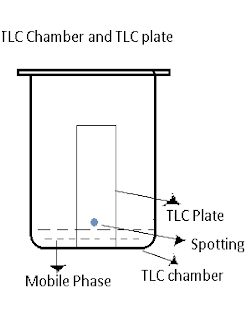Thin Layer chromatography is one of the simplest technique among
the Chromatography technique and easy to perform. Mainly used for
identification of the Component from the mixture.
Thin layer Chromatography Experiment Procedure:
The mobile phase or the mixture of the mobile phase is poured into the TLC chamber in the required quantity. And saturated the TLC chamber with the mobile phase.
In earlier people are prepare the thin layer chromatography plate in Lab. It includes the preparation of the TLC plate, activation of the TLC plate.
Preparation of TLC Plate:
The slurry of silica or stationary phase is prepared and the
slurry is applied on the glass plate or the alumina plate and layer allowed
drying. For drying oven is used. The plate is ready to use.
After that TLC plate preparation Spotting on The TLC plate is done. Dissolve the sample in a suitable solvent For spotting
on the TLC plate glass capillary is used.
Place the TLC plate in the chamber, ensuring that the
spots on TLC plate should not be dipped
into the mobile phase and close the chamber.
Mobile phase is run on the TLC plate in ascending way
and remove the plate.
Make a mark with pencil on the TLC plate up to which
ark mobile phase run and dry the TLC plate.
Visually inspect the TLC plate you can see the spot of
analyte on the TLC plate.In some TLC plate, it is not possible to visualize the
spot directly.
You should apply any reagent spray or you need to
observe it into the UV light then you
can see the spot on the TLC plate.
Calculate the Rf Factor of the TLC plate.
Related Post:
Complete Separation of Component from the Mixture
Thin Layer Chromatography: Basic, Application, and principle of Thin Layer Chromatography



No comments:
Post a Comment